- This post contains affiliate links. Read more here.
- Not a substitute for professional veterinary help.
Just like humans, cats are susceptible to skin problems. If you notice your cat excessively scratching, licking, or biting at their skin, these can be some of the first signs of cat skin problems and skin problems are fairly common, according to Dr. Shannon Barrett, owner of Downward Paws. However, if you’re unsure of what’s causing your cat’s unhealthy skin or are worried, it’s always best to contact a trusted veterinarian.
With Dr. Barrett’s help, we’ll take a look at the most common cat skin problems and what to do about them.
Symptoms of Cat Skin Problems
Healthy cat skin contains sebaceous glands that produce a high level of oil that helps repel dirt and water. However, if your cat has unhealthy skin, here are some of the most common symptoms associated with skin conditions in cats:
- Excessive itching/biting of the skin
- Excessive grooming
- Redness
- Dryness
- Bald patches
- Acne or Pustules
- Foul odor or discharge
- Scabbing
Cat Allergies
According to Dr. Barrett, skin allergies on cats are one of the most common cat skin problems.
- Symptoms: Scratching, biting, licking, chewing at the skin, and hair loss.
- Causes: Allergens can be from a wide range of possibilities, including dust mites and pollen.
- Treatment: Symptoms and causes are key in determining the appropriate treatment. General options include diet changes, antihistamines or topical medications, and allergen-free toys, beds, and accessories.
- Additional Info: It’s best to remove the allergen from the environment, if possible. “Since allergies have so many causes, it’s essential to work with your vet and slowly eliminate any potential sources systematically,” she notes.
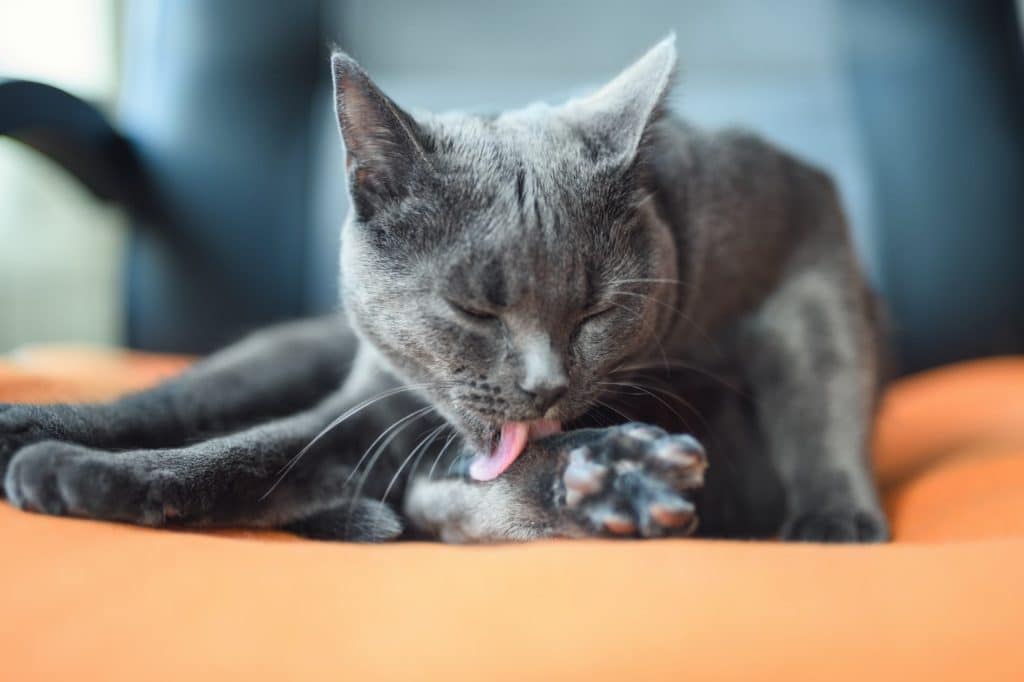
iStock/cunfek
Cat Dermatitis
Dermatitis is inflammation of the skin.
- Symptoms: Inflammation, redness, scaling, crusting, and hair loss.
- Causes: Fleas, allergies, ringworm, and other irritants to the skin.
- Treatment: Depends on the underlying cause. Treatments may be topical, oral antibiotics, antihistamines, or shampoos.
- Additional Info: It’s important to identify the underlying cause of your cat’s dermatitis, which is why bringing your cat to the vet for a diagnosis is important.
Cat Acne
Acne is a skin problem where the hair follicles are plugged up by dead skin cells and oil.
- Symptoms: Bumps or pimples, especially around the chin and lips—often darkened or thickened skin around the chin.
- Causes: The exact cause is not known, but Dr. Barrett says it can be related to changes in hormone levels, diet, contact irritation from plastic food bowls, or stress.
- Treatment: There is no one-size-fits-all treatment. Diet and lifestyle changes or prescription medication may be options.
- Additional Info: This is a common skin condition in cats, and it is an ongoing issue that requires regular care and cleaning. “Setting up a maintenance routine with your vet is ideal when dealing with feline acne,” says Dr. Barrett.
Cat Ear Mites/Infections
While both are relatively common, ear infections in the ear are more frequent than ear mites.
- Symptoms: Ear mites cause a dark, coffee grounds-like discharge that coats the inside of the ear and is more common in kittens and stray cats. Ear infection symptoms include discharge and scratching and occur more frequently.
- Causes: Ear mites are caused by a tiny parasite in the ear canal and are contagious. Ear infections have many causes, oftentimes due to underlying allergies.
- Treatment: For ear mites, a topical medication is used for the ears to kill the mites. As for ear infections, it is dependent on the underlying cause.
- Additional Info: Both conditions are diagnosed by taking a sample from the cat’s ear to be examined with a microscope.
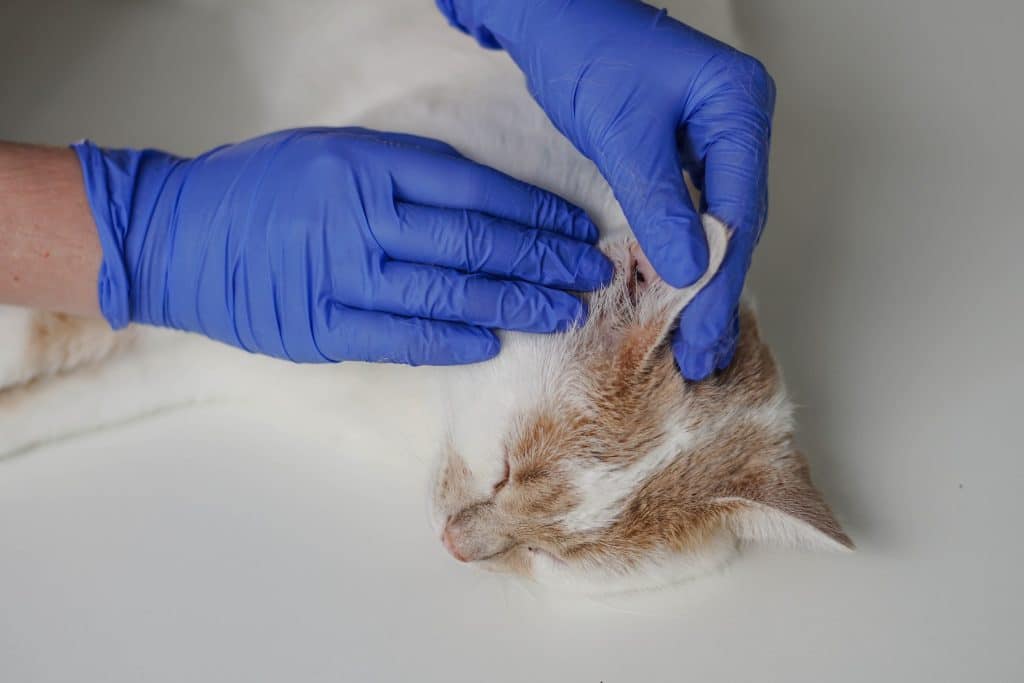
iStock/Hleb Usovich
Cat Rashes
Rashes are a change in the color or texture of the skin.
- Symptoms: Skin redness or bumpy appearance.
- Causes: Allergies, infections, parasites, autoimmune disorders, and cancer.
- Treatment: Dependent on the underlying cause, but can include antibiotics, antihistamines or steroids, dewormers, or chemotherapy.
- Additional Info: Since the causes are so varied, rashes are fairly common. Mild allergic rashes may resolve on their own, but it’s best to get help.
Cat Mange
Mange is a term that encompasses cat skin problems caused by mites.
- Symptoms: Scratching, bald patches, redness, and crusts on the skin.
- Causes: Some mites can be transferred from cat to cat, while others are not. Demodex mites are found on nearly all cats and do not cause issues; however, on some cats, mites proliferate due to a weak immune system or mite allergy and therefore cause skin irritation and hair loss.
- Treatment: Depends on the type of mites, each species dictates different treatment.
- Additional Info: Demodex mites are the most common. Mites are identified using a scalpel to scrape skin and hair cells for examination under a microscope. Mange is rare but requires a trip to the veterinarian.
Cat Fungal Infections
Infections to the skin and hair caused by a fungus. Ringworm (see further down) is a well-known type of fungal infection.
- Symptoms: Redness, lesions, or thin/broken hair are possible.
- Causes: Contact through compromised skin with animals or objects infected by fungus.
- Treatment: Topical or oral anti-fungal medications.
- Additional Info: Long-haired cats, especially Persians, can be susceptible.
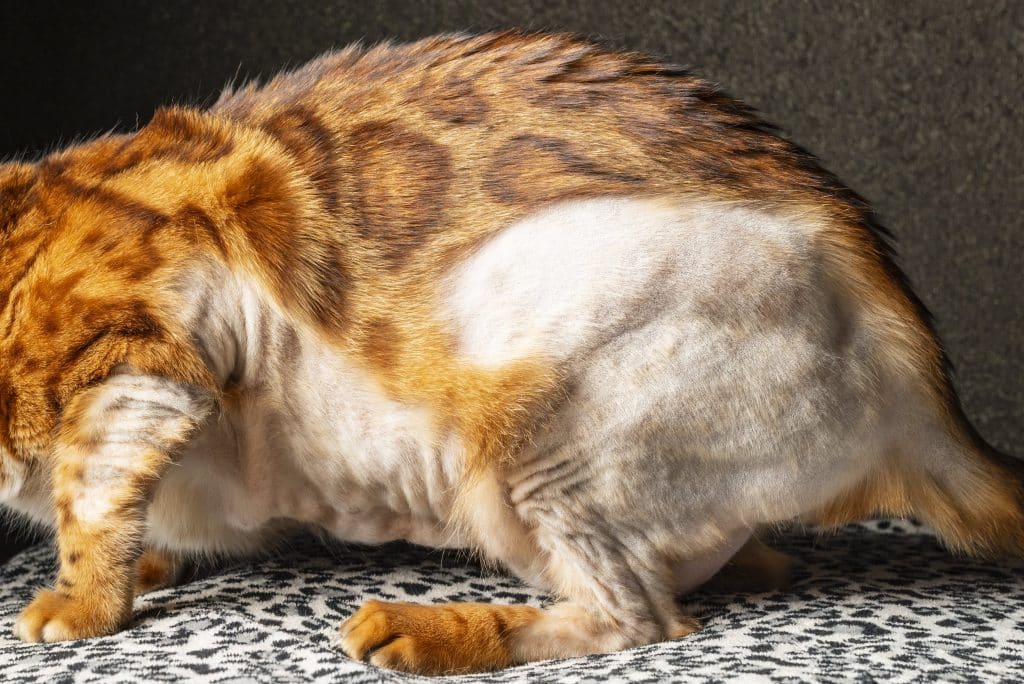
iStock/Azovsky
Cat Hair Loss
Hair loss is also known as alopecia.
- Symptoms: Bald patches on the skin and excessive shedding.
- Causes: Several, including infections, allergies, and autoimmune diseases. “Alopecia in cats is almost always secondary to an underlying cause; therefore, treatment is targeted at the underlying issue,” says Dr. Barrett.
- Treatment: Treatments may include antibiotics, antihistamines, or corticosteroids—depending on the cause.
- Additional Info: Alopecia is often a sign of more severe skin diseases, and it’s best to work with your vet to single out the cause.
Cat Dry Skin & Dandruff
Both dry skin and dandruff are common in cats.
- Symptoms: Scratching, hair loss, and scales on the skin.
- Causes: Experts don’t fully understand dry skin causes, but they may include a dry environment, allergies, parasites, or poor nutrition.
- Treatment: Possible treatments include diet changes, leave-in cat conditioner, a humidifier, prescription medications, or supplements.
- Additional Info: Long-haired and overweight cats can be most susceptible. If simple solutions like conditioner or diet change aren’t helping, consult your vet to rule out causes.
Cat Fleas & Ticks
Flea allergies are prevalent in cats and can often look the same as other cat skin problems.
- Symptoms: For fleas, excessive scratching, especially neck and legs, and possibly red or flaky skin patches. For ticks, skin irritation and inflammation at attachment site.
- Causes: Exposure to fleas or ticks in the outdoors or, in the case of fleas, other animals that may be carrying them or bring them inside.
- Treatment: In the case of ticks, treatment includes removing the tick manually and antibiotics if the infection is severe. Fleas involve topical medication.
- Additional Info: Prevention medication for both fleas and ticks can help eliminate the problem before it starts.
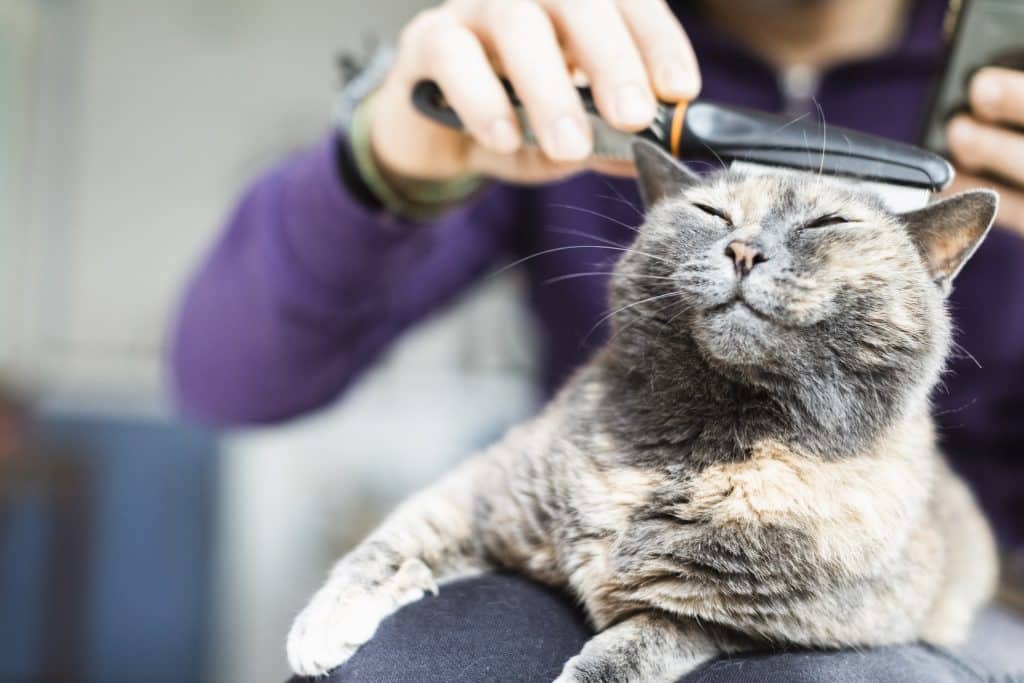
iStock/deimagine
Cat Ringworm
Also known as dermatophytosis, ringworm is a fungal infection.
- Symptoms: Broken or thinning hairs, scaly patches, redness, or crusty lesions. Carriers may show no symptoms.
- Causes: Dermatophytes enter through skin compromised by a cut or abrasion and can be spread through contact with an infected animal or object. Kittens or cats with weakened immune systems are at higher risk. Outdoor cats, particularly in humid climates, are also more susceptible, as well as long-haired cats, especially Persians.
- Treatment: Topical or oral antifungal medications, as well as cleaning the environment to kill the fungus.
- Additional Info: Ringworm is not caused by a worm. Due to cat fur, the infection does not necessarily have a ring appearance. Your vet diagnoses ringworm using a specific skin brushing technique to monitor samples over several days. Though rare, ringworm is severe if left untreated.
Cat Erythema
Erythema, is an uncommon inflammatory skin problem.
- Symptoms: Redness or lesions.
- Causes: Allergies and allergic reactions, infections, and parasites may be some possibilities. In some cases, the cause is unknown.
- Treatment: Treatments depend on the cause and can range from removing the allergen from the environment to antibiotics.
- Additional Info: Diagnosis often includes a biopsy of the affected skin.
When To See A Vet For Cat Skin Problems: A Helpful Checklist
It’s important to seek out the help of a veterinarian if you are concerned about your cat’s skin problems. Here are some questions you can ask yourself if you’re on the fence about taking your cat to the vet.
-
When did the skin symptoms start, how long have they lasted, and are they getting worse?
-
Have there been any recent food changes, or have you added any new food or treats?
-
Is your cat indoors or entirely outdoors?
-
Do you have any dogs or other pets in the house?
-
What flea and or heartworm prevention do they receive?
-
Have you changed litter?
-
What is the distribution of skin issues? Does your cat only have an ear infection, or is he scooting? Is he only licking his abdomen or the sides of his body? Are they itching their neck?
-
Have you noted any non-skin-related issues? Has their appetite changed? Has their water consumption changed? Are their litter box habits normal? Have they lost or gained weight?
Vets use many methods to examine skin problems. Dr. Barrett says that for noticeable skin lesions, vets take a sample from the affected area and examine it with a microscope. “This can tell us if there is an overgrowth of bacteria or yeast on the skin.” Kittens may be tested for parasites and additional blood and urine samples may be checked for medical conditions. If it is an advanced dermatology case, a skin biopsy may be performed.
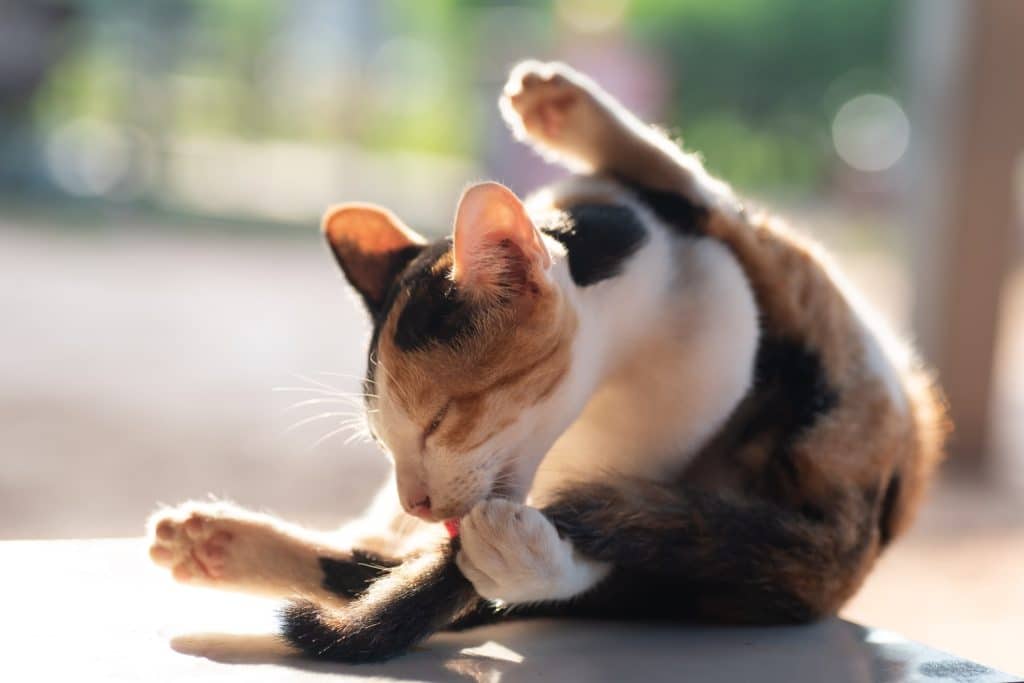
iStock/Nungning20
How Can I Prevent Cat Skin Problems?
One way to help reduce or prevent cat skin problems? Give ’em a grooming! “Regular brushing can help remove any built-up dirt or debris, as well as help keep their coat looking shiny and healthy,” says Dr. Barrett.
Looking for some kitty grooming products? She recommends Furminator brushes for getting at a cat’s undercoat and Millers Forge nail trimmers to help minimize the trauma of scratching the skin.
As Dr. Barrett says, “A simple grooming routine allows you to check for any potential skin problems before they become serious.”





